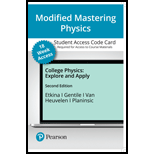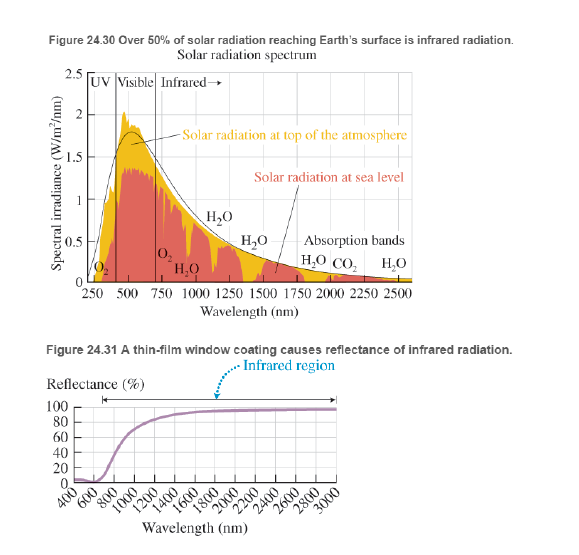
Concept explainers
Thin-film window coatings for energy conservation and comfort Thin-film coatings are applied to eyeglasses, computer screens, and automobile instrument panels to reduce glare and to binocular and camera lenses to increase the amount of light transmitted. Thin-film coatings are also used to add color to architectural glass, to reduce surface friction, and to improve the energy efficiency of windows. Consider this latter application.
Figure 24.30 shows that over 50% of the

The actual thin film built for windows reflects about what percent of the incident infrared radiation at 1000 nm?
a. 10
b. 30
c. 50
d. 70
e. 90
Want to see the full answer?
Check out a sample textbook solution
Chapter 24 Solutions
Modified Mastering Physics with Pearson eText -- Access Card -- for College Physics: Explore and Apply (18-Weeks)
Additional Science Textbook Solutions
Anatomy & Physiology (6th Edition)
Human Biology: Concepts and Current Issues (8th Edition)
Microbiology with Diseases by Body System (5th Edition)
Chemistry: Structure and Properties (2nd Edition)
Microbiology: An Introduction
Human Anatomy & Physiology (2nd Edition)
- Please don't use Chatgpt will upvote and give handwritten solutionarrow_forwardIf A - B = 0, then the vectors A and B have equal magnitudes and are directed in the opposite directions from each other. True Falsearrow_forwardIf the eastward component of vector A is equal to the westward component of vector B and their northward components are equal. Which one of the following statements about these two vectors is correct? Vector À is parallel to vector B. Vectors À and point in opposite directions. VectorÀ is perpendicular to vector B. The magnitude of vector A is equal to the magnitude of vectorarrow_forward
- No chatgpt plsarrow_forwardConsider the situation in the figure below; a neutral conducting ball hangs from the ceiling by an insulating string, and a charged insulating rod is going to be placed nearby. A. First, if the rod was not there, what statement best describes the charge distribution of the ball? 1) Since it is a conductor, all the charges are on the outside of the ball. 2) The ball is neutral, so it has no positive or negative charges anywhere. 3) The positive and negative charges are separated from each other, but we don't know what direction the ball is polarized. 4) The positive and negative charges are evenly distributed everywhere in the ball. B. Now, when the rod is moved close to the ball, what happens to the charges on the ball? 1) There is a separation of charges in the ball; the side closer to the rod becomes positively charged, and the opposite side becomes negatively charged. 2) Negative charge is drawn from the ground (via the string), so the ball acquires a net negative charge. 3)…arrow_forwardanswer question 5-9arrow_forward
- AMPS VOLTS OHMS 5) 50 A 110 V 6) .08 A 39 V 7) 0.5 A 60 8) 2.5 A 110 Varrow_forwardThe drawing shows an edge-on view of two planar surfaces that intersect and are mutually perpendicular. Surface (1) has an area of 1.90 m², while surface (2) has an area of 3.90 m². The electric field in the drawing is uniform and has a magnitude of 215 N/C. Find the magnitude of the electric flux through surface (1 and 2 combined) if the angle 8 made between the electric field with surface (2) is 30.0°. Solve in Nm²/C 1 Ө Surface 2 Surface 1arrow_forwardPROBLEM 5 What is the magnitude and direction of the resultant force acting on the connection support shown here? F₁ = 700 lbs F2 = 250 lbs 70° 60° F3 = 700 lbs 45° F4 = 300 lbs 40° Fs = 800 lbs 18° Free Body Diagram F₁ = 700 lbs 70° 250 lbs 60° F3= = 700 lbs 45° F₁ = 300 lbs 40° = Fs 800 lbs 18°arrow_forward
 College PhysicsPhysicsISBN:9781938168000Author:Paul Peter Urone, Roger HinrichsPublisher:OpenStax College
College PhysicsPhysicsISBN:9781938168000Author:Paul Peter Urone, Roger HinrichsPublisher:OpenStax College Glencoe Physics: Principles and Problems, Student...PhysicsISBN:9780078807213Author:Paul W. ZitzewitzPublisher:Glencoe/McGraw-Hill
Glencoe Physics: Principles and Problems, Student...PhysicsISBN:9780078807213Author:Paul W. ZitzewitzPublisher:Glencoe/McGraw-Hill Principles of Physics: A Calculus-Based TextPhysicsISBN:9781133104261Author:Raymond A. Serway, John W. JewettPublisher:Cengage Learning
Principles of Physics: A Calculus-Based TextPhysicsISBN:9781133104261Author:Raymond A. Serway, John W. JewettPublisher:Cengage Learning Physics for Scientists and EngineersPhysicsISBN:9781337553278Author:Raymond A. Serway, John W. JewettPublisher:Cengage Learning
Physics for Scientists and EngineersPhysicsISBN:9781337553278Author:Raymond A. Serway, John W. JewettPublisher:Cengage Learning Physics for Scientists and Engineers with Modern ...PhysicsISBN:9781337553292Author:Raymond A. Serway, John W. JewettPublisher:Cengage Learning
Physics for Scientists and Engineers with Modern ...PhysicsISBN:9781337553292Author:Raymond A. Serway, John W. JewettPublisher:Cengage Learning Physics for Scientists and Engineers, Technology ...PhysicsISBN:9781305116399Author:Raymond A. Serway, John W. JewettPublisher:Cengage Learning
Physics for Scientists and Engineers, Technology ...PhysicsISBN:9781305116399Author:Raymond A. Serway, John W. JewettPublisher:Cengage Learning





